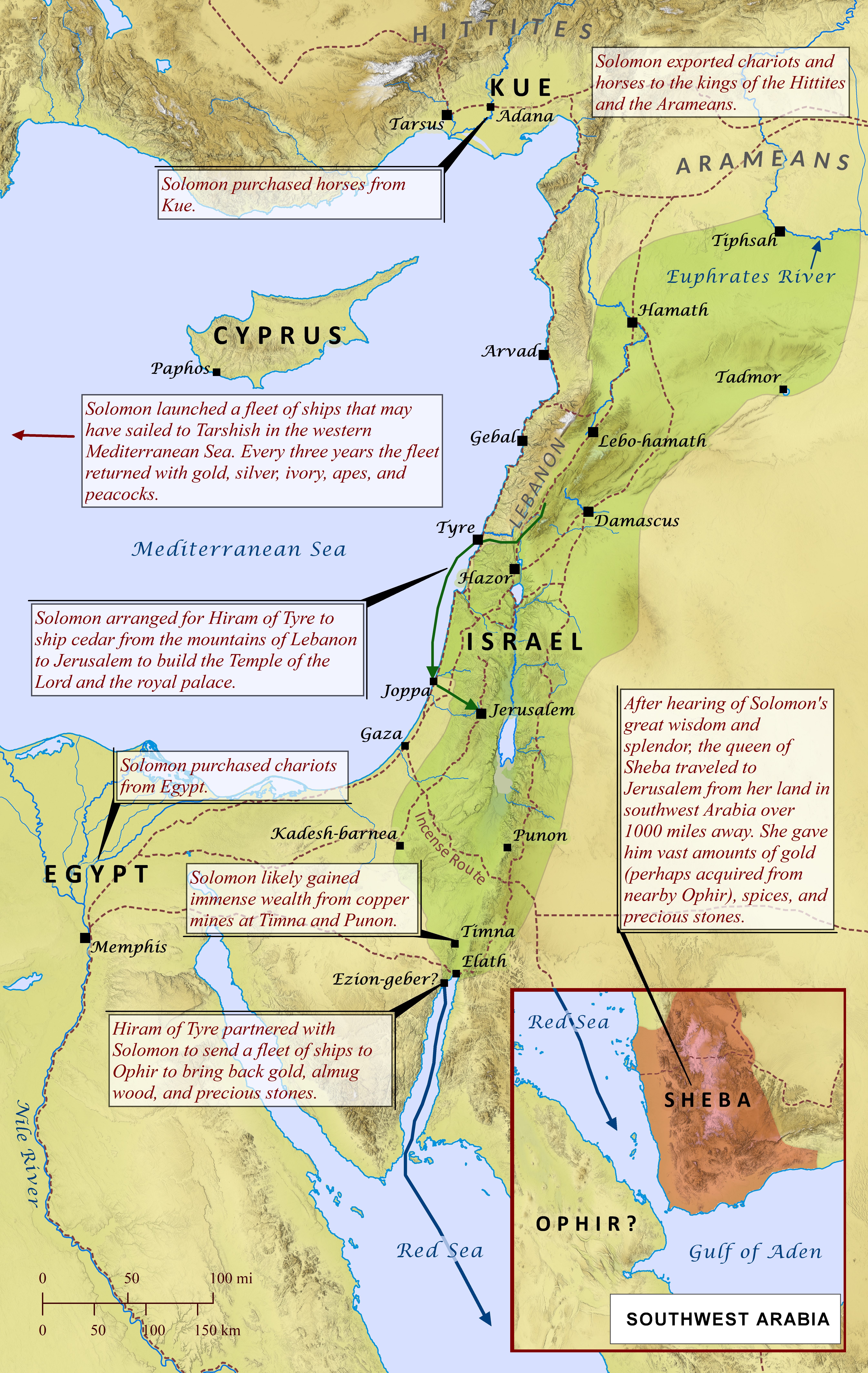
Solomon’s International Presence
1 Kings 9-10; 2 Chronicles 2:1-18; 8:1-9:28
Near the beginning of Solomon’s reign, the Lord promised to bless him with great wisdom, riches, and honor (1 Kings 3:2-15), and the fulfillment of this promise led to great fame for Solomon throughout the Near East. Humanly speaking, Solomon had been set up for immense success by his father David, who passed on to him a powerful kingdom that stretched from the tip of the Red Sea to the Euphrates River (2 Samuel 8-10; 1 Chronicles 18-19; 2 Chronicles 8). During Solomon’s reign Israel controlled all land routes leading from Egypt and the Red Sea to the Aramean and Hittite nations to the north, and they also controlled the northern terminus of the great Incense Route leading from the peoples of southwest Arabia to the shores of the Mediterranean Sea at Gaza. Solomon appears to have capitalized on his strategic control over travel and shipping throughout the region by setting up a very lucrative international arms dealership, through which he paired chariots bought from Egypt with horses bought from Kue (the term sometimes translated as “Egypt” should probably be translated “Muzur,” a district near Kue) and sold them to the kings of the Hittites and Arameans. Solomon also likely gained immense wealth from very productive copper mines at Punon, Timna, and elsewhere (see “Southern Arabah Valley” map). All this won him great renown among all the rulers of the Near East, including the queen of Sheba, who traveled over a thousand miles to see for herself Solomon’s great wisdom and splendor. She brought with her luxurious gifts from her land, including spices, precious stones, and gold, which she may have obtained from nearby Ophir. Solomon also arranged for King Hiram of Tyre to provide him with cedar timbers from Lebanon to build the Temple of the Lord and his royal palace (2 Chronicles 2). The logs were bound into rafts, floated down to Joppa, and then disassembled and hauled up to Jerusalem. Solomon also launched ships to sail to faraway lands during his reign and bring back riches and exotic goods. Scholars have proposed various locations for the exact destination of the ships, and some have struggled to reconcile what can seem like confusion on the part of the biblical writers over the term Tarshish. But a careful reading of the biblical accounts indicates that there were probably two separate fleets of ships: the fleet of Hiram and Solomon’s fleet of ships of Tarshish. Both fleets are separately mentioned in 1 Kings 10:22, and the phrase “at sea with” may simply indicate that they were sailing at the same time but not necessarily together. Also, the list of goods brought back by Hiram’s fleet is somewhat different than the list of goods brought back by Solomon’s fleet (compare 1 Kings 10:11, 22; 2 Chronicles 8:17-18; 9:10, 21). Likewise, the wording of 2 Chronicles 8:17-18 is that Hiram “sent to [Solomon] by the hand of his servants ships and servants familiar with the sea,” but the implication seems to be that the ships remained Hiram’s, not Solomon’s, whereas the other fleet of ships of Tarshish appears to have belonged to Solomon, though the ships were manned by Hiram’s men as well (2 Chronicles 9:21). Thus, Hiram’s fleet set sail from Ezion-geber, traveled the length of the Red Sea, and acquired gold from Ophir. Solomon’s fleet, on the other hand, could have sailed either the Red Sea or the Mediterranean Sea, since the term ships of Tarshish seems to have been used at times to indicate a class of trading or refinery ships rather than a specific destination (see article for “Tarshish” map). It is also possible, however, that the term Tarshish referred to the ships’ actual destination, which during Solomon’s reign appears to have been located in the far western Mediterranean Sea. This is supported by isotopic studies of silver found in Israel during Solomon’s time, which have traced the source to Tharros on the island of Sardinia. This also fits well with the length of time given for the voyage of Solomon’s fleet, which returned every three years with their exotic goods.